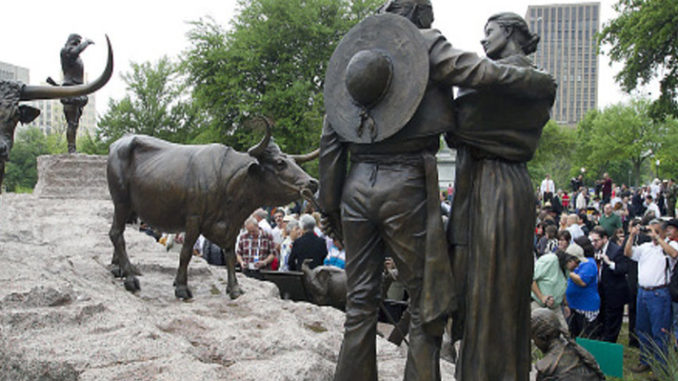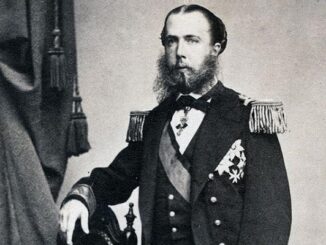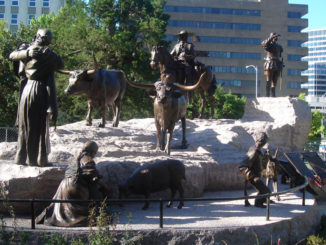
The controversy engulfing the centuries-old site is part of a much larger national reckoning over monuments and statues that critics say wrongly honor Confederate leaders and others who contributed to a shameful legacy of racism and anti-Mexican sentiment.
by
Should William Barret Travis, whose name is enshrined on schools, monuments and public buildings across Texas, continue to be honored solely as the valiant commander who led vastly outnumbered defenders of the Alamo in their doomed 13-day siege in the 1836 battle for state independence?
Or should he also be seen through another lens—that of a “pompous, racist agitator” helping lead a revolt by Texas colonists primarily to preserve slavery in what was then an outlying part of northern Mexico?
That second description comes in a recently published book that is fanning a new battle of the Alamo over the causes and details of an event that has been at the center of Texas popular culture for generations. And the debate surrounding the book’s conclusions—along with other critiques of the Alamo narrative—echoes the question increasingly bubbling up in legislatures and school boards around the country: How should we teach and remember the nation’s unflattering history?
Written by three Anglo men, all former or active journalists, the 386-page “Forget the Alamo” also reintroduces other legendary figures, depicting the Alamo garrison’s co-commander James Bowie as “a murderer, slaver, and con man” and frontier legend and Alamo combatant Davy Crockett as a “self-promoting old fool.”
The authors write that it’s time to dismantle the “Heroic Anglo Narrative” that they say has obscured the importance of Hispanic, Black and Native American people in Texas’ history. Nor, they add, should the Alamo, which draws more than 1.5 million visitors a year, continue to be hailed as the “shrine of Texas liberty.”
The authors and their myth-busting have ignited a fierce pushback from Texas political leaders and modern-day defenders of the Alamo at a time when Texas’ best-known landmark is undergoing a nearly $400 million renovation.
“People would rather fight about the Alamo than fight for the Alamo,” said Douglass McDonald, former CEO of the Alamo Trust, a nonprofit that manages the monument on behalf of the Texas General Land Office. McDonald, who worked on redeveloping the Alamo before leaving in 2020, said the book’s arguments give more attention to those “who disparage the Alamo than to the many of us who advance the full history” of the landmark.
The controversy engulfing the centuries-old site is part of a much larger national reckoning over monuments and statues that critics say wrongly honor Confederate leaders and others who contributed to a shameful legacy of racism and social intolerance.
In Richmond, Virginia, workers last week removed one of the country’s largest Confederate monuments, a towering statue of Gen. Robert E. Lee. Rhode Island voters in November approved a ballot measure to remove the words “Providence Plantations” from the official state name. And countless schools and roads have been renamed in recent years. But such moves have drawn pushback from critics who argue that today’s standards shouldn’t be applied to historical figures and phrases.
Tense confrontations erupted at Alamo Plaza in May 2020 following the police killing of George Floyd in Minneapolis. Protesters demanding an end to police brutality faced off against Alamo defenders who call themselves the This is Texas Freedom Force, some of whom wore body armor and carried weapons. Graffiti spray-painted on the Cenotaph, a monument bearing the names of people who died at the Alamo, read, “white supremacy, profit over people, the ALAMO.”
Just last week, the president of the University of Texas at San Antonio announced that the slogan “Come and Take It” will no longer be displayed on buildings or used as a rallying cry at football games after petitioners denounced it as racist and anti-Mexican.
The phrase has roots in the motto that residents of the Texas colony of Gonzales wrote on a flag in 1835 to resist Mexican attempts to retrieve a cannon. The phrase increasingly has been associated with White supremacy groups and was on display during the Jan. 6 insurrection at the U.S. Capitol.
The controversies over Texas history have provoked the state’s GOP lawmakers. In June, the Republican-led Texas legislature passed and GOP Gov. Greg Abbott signed a law creating the 1836 Project, which launched Sept. 1.
The project, named after the year Texas won its independence from Mexico, creates a state advisory committee that Abbott said would “promote patriotic education and increase awareness of the Texas values.” The committee also will distribute pamphlets extolling the state’s virtues to people getting their driver’s licenses.
The name echoes the Pulitzer-Prize winning 1619 Project, a collection of essays by The New York Times about the deep roots of racism in the United States. Since its publication, it has become a target of conservative critics who argue it’s unpatriotic. The New York Times journalist behind that project, Nikole Hannah-Jones, tweeted that the Texas law creating the 1836 Project “is part of a legacy of the government banning the discussion of slavery.”
Texas was originally part of Mexico but broke away following the Texas Revolution from 1835 to 1836, when it became an independent republic and adopted a constitution legalizing slavery. Texas joined the union in 1845.
Sitting in the downtown heart of the nation’s seventh-largest city, Alamo Plaza is in the midst of an ambitious expansion, controversial from the outset, that will add an exhibition hall and collections building in 2022, followed by a museum and visitor center in 2025.
The project, a collaboration among the General Land Office, the city of San Antonio and the Alamo Trust, took a hit in “Forget the Alamo.” The authors, while conceding that Alamo Plaza “desperately needs a refresh,” wrote that spending millions on a “monument to white supremacy” is a “grave injustice to a city that desperately needs better schools, jobs and services.”
Alamo Trust Director Kate Rogers declined to comment on the book but defended both the Alamo and the renovation project. “There’s a lot of reasons why the Alamo means a lot to people,” she said, adding that planners are committed to tell “the full history of the site” and promote “healthy discourse” through “different lenses, different perspectives.”
Asked whether the publication has had a negative impact on the Alamo, she responded, “To be honest, not really any.”
Since the June release of “Forget the Alamo,” its authors have received a “couple of death threats” and vows “to beat us up,” but the overall reaction has been relatively tame, said Chris Tomlinson, a co-author and a columnist for the Houston Chronicle and San Antonio Express-News.
“I’m surprised there haven’t been more,” said Tomlinson. “I knew there was a portion of the population that was going to be offended and that portion turned out to be a lot smaller than I thought it was going to be.”
Tomlinson and co-authors Bryan Burrough and Jason Stanford attribute that reaction to changing demographics, saying people who grew up with the heroic Alamo imagery of the 1950s and ‘60s are aging while younger readers have fewer preset opinions.
Nevertheless, “Forget the Alamo” has made a few headlines. Just weeks after the book was released in June, Texas Lt. Gov. Dan Patrick, a Republican, blocked a promotional event with the three authors that was set to happen at Austin’s Bullock Texas State History Museum. Patrick, a member of the State Preservation Board that oversees the museum, tweeted “This fact-free rewriting of TX history has no place @ Bullock Museum.”
One of the most visible detractors is Jerry Patterson, who served as land office commissioner from 2003 to 2015. He was followed by current Land Commissioner George P. Bush, who is helming the Alamo renovation efforts.
Patterson met with British rocker and Alamo buff Phil Collins in 2014 to negotiate the state’s acquisition of over 400 of the musician’s artifacts now destined to be a centerpiece exhibit in the Alamo. A final chapter of “Forget the Alamo” questions the authenticity of a number of items,which include rifles, pistols, powder horns and documents.
Patterson, who has launched a website refuting several of the book’s central points, defends Collins’ collection as a “generous donation” and said any claim that the land commission was misled about any of the items “is just false.” The Republican former state official also contends that the book’s assertion that slavery was an underlying motivation for the Texas Revolution is “not supported by fact.”
Lee Spencer White, president and founder of the Alamo Defenders Descendants Association, calls “Forget the Alamo” one of a litany of Alamo “hate books.” She said she has traced her lineage to a man who died at the Alamo, Gordon C. Jennings. She calls him a “common man” who did not own slaves and refers to the Alamo as “my family cemetery.”
Other Texans, including Hispanic and Black leaders, hail the book as a long-awaited validation from White authors of their contention that their ancestors’ place in Texas history has been largely ignored or misrepresented.
“Growing up as a Mexican-American, or Chicano in South Texas, the stories that we were taught and the lore that we were taught was always in the negative in reference to our culture and what actually happened at the Alamo,” said Rodolfo Rosales Jr., state director of the League of United Latin American Citizens, the largest and oldest Hispanic and Latino civil rights organization in the country.
“I think it was profoundly significant that they did bring this book out,” he said, adding that it gives needed traction to research and studies that Latino experts have pursued for years.
Similarly, Gary Bledsoe, state president of the NAACP, said the broadened discussion generated by the book will focus needed attention on Black residents who participated in the Texas Revolution, including Hendrick Arnold, who fought in a key battle preceding the siege at the Alamo, and Samuel McCulloch, who was one of the men who attacked the Mexican Army Garrison at Goliad.
“People like Bowie are given undue credit and exalted, and Black and Brown people are diminished,” Bledsoe said. The Austin lawyer said he also hopes the shifting focus on Texas history will help fuel his organization’s efforts to make an optional African American history course mandatory in public schools, which teach Texas history in the fourth and seventh grades.
The widening look into the state’s past also has resurrected troubling reminders of a time when film and television depictions of a rifle-swinging Crockett and sword-waving Travis prompted discrimination against Mexican Americans.
Richard Flores, a professor of anthropology and Mexican American studies at the University of Texas at Austin, said he experienced racism when he toured the Alamo with his third-grade class. As he and his classmates emerged from the old mission after being told of fallen icons such as Travis, Crockett and Bowie, “a good friend of mine nudged me and said, ‘You killed them, you and other Mexicans,’” Flores, now 65, recalled recently. He also recounted the episode in his 2002 book, “Remembering the Alamo.”
To state Rep. Trey Martinez Fischer, a San Antonio Democrat who grew up about 2 miles from the fabled downtown memorial, the Alamo “has meant different things to me at different times.”
Whenever boyhood cousins came from Minnesota or Illinois, the family would pile into the car and head to the shrine, he recalled. Now a public servant in his 50s, Martinez Fischer says he has a broader and more enlightened understanding of the Alamo and its historical context.
“I’m proud that our community has that respect and willingness to preserve our history,” he said. But at the same time, added the lawmaker, “we have to tell the entire story of the Alamo, even the unflattering and inelegant portions of it. And there are folks that would rather not have that conversation and instead want to find a way to sweep it all under the carpet. And I just don’t think that’s appropriate at all.”



